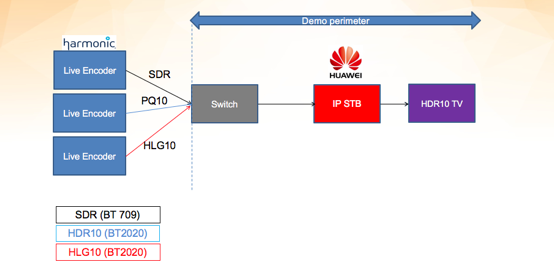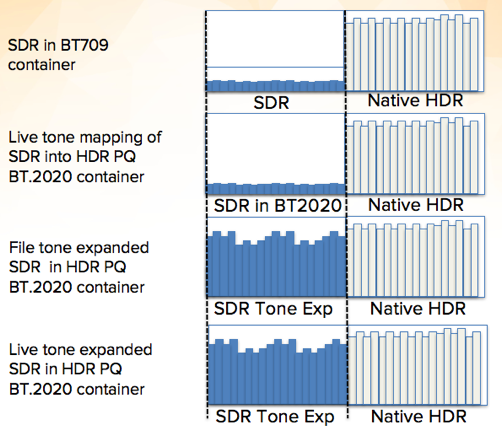The Ultra HD Forum have four demonstrations for IBC2017 set in the context of “HDR FOR ALL”, demonstrating a full e2e IPTV UHD HDR service by KPN, SDR and HDR conversion techniques to be used in managing content harmonisation/display adaption, and finally a demonstration of key aspects of the next phase of UHD development – High Frame Rate combined with HDR.
With the commercialisation and deployment now of consumer UHD services, operators are moving beyond the early adopters and delivering these new services to the mass market, which means display on a wide range of display devices, from high end to low end, from HDR capable to SDR capable. The forum is here to show that the technical solutions are available now to do this with operational efficiency.
Demo 1: Live HDR IPTV
Linear delivery of HDR video is critical for service providers, particularly for Sports content.

KPN IPTV technical demo with HDR
KPN bring to IBC a technical demonstration of their complete end to end UHD HDR delivery to current customer equipment. The content is encoded at KPN facilities and delivered over their IPTV access network via multicast to current receiver equipment that has been software upgraded to support the latest HDR capabilities. The demo shows PQ transfer function encoded video as defined in SMPTE ST.2084/2086 and ITU BT.2100, presented to consumer displays. These consumer displays represent mid-tier (€700 to €1000) and high-end (>€1500) HDR TV scenarios. The visual quality is great on the mid-tier display and even better on the high end, providing a great viewer experience for all ends of the market.
Demo 2: STB HDR Conversion
The next demo shows techniques for display adaption to convert varied content (SDR/HLG/PQ) from SDR and HLG to PQ, allowing reception of mixed SDR/HDR video when the TV display supports HDR in PQ, all processed by the STB.

HDR format conversion in the STB demo
In the demo, the STB receives video and depending upon the received format will convert or pass-through to PQ for display on the TV. When receiving SDR encoded video, the STB decodes and converts the stream to PQ and the TV displays this in PQ mode. When receiving the HLG encoded video, the STB decodes and converts the HLG video stream to PQ format for the TV to display. When receiving the PQ encoded video, the STB passes through the video and the TV displays this in PQ mode.
Regardless of the received video stream, the TV display continues in PQ mode without any switching of the working mode, providing a seamless experience for the consumer. Although focused on conversion to PQ, this approach can also be applied to conversion to HLG for display.
Demo 3: SDR>HDR Headend Conversions
This demo shows a number of techniques for Head End conversion from SDR to PQ, allowing reception of HDR video on the TV even if the source is SDR, compared to the native presentation of PQ.

Demo: SDR to HDR Conversion in headend
Source material in SDR, Tone mapped SDR, Tone expanded SDR and native PQ is presented to two different STBs, one which undertakes PQ display adaption (Huawei) and one that does not (Sigma Designs). The demo shows the varying and increasing quality of SDR to HDR conversion that can be achieved by the various conversion techniques from base SDR through to native PQ, shown in the diagram below.
This demonstration shows what is possible to convert File or Live SDR content to HDR to provide a consistent, operator controlled HDR experience. It also shows the increasing quality improvement with the content from its SDR base to the converted versions and a final comparison with a native PQ10 variant. It also demonstrates just how much SDR content can be improved in its representation so that it approaches the quality of full HDR on the TV display.
Demo 4: High Frame Rate
Past the forum’s definitions of Phase A, there are Phase B technologies. One of these is High Frame Rate Video – the delivery of video at 100 or 120 fps or higher. The demo at IBC shows 120fps HFR/HDR HD resolution video, which is stunning compared to the same content shown in standard dynamic range and frame rates. HFR brings the possibility of more realistic-looking video for a minimal increase in bitrate, adding to the existing features of UHD such as HDR.
The content as presented shows a variety of examples of video including normal drama scenes and high motion sports. Sports and other high motion video is particularly effective. HFR at 1080p resolution is more than feasible in the near term and tempts the promise of this at full UHD resolutions as technologies develop.
The Demos and the Interop Working Group
These demos have been brought together by participating member companies of the Ultra HD Forum Interop Working Group. The Working Group is tasked with facilitating interoperability work and plug-fests to test usability and comprehensiveness of Ultra HD and related media standards including the Forum’s Guidelines. We also promote the use of UHD and related services that meet the scope of the Forum, these demos stand in that context.
